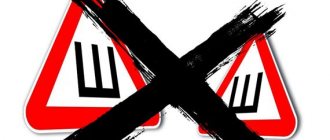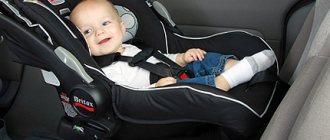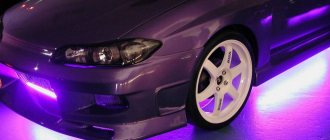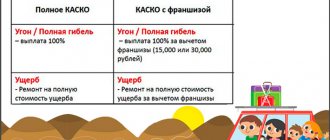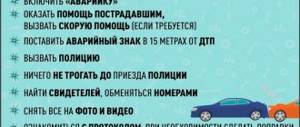Penalties for using/non-using a booster
Since the Rules do not mention this term, it is also absent from the Code of Administrative Offences. Regarding the rules for transporting children, there is a general rule (Article 12.023, Part 03), which states that a corresponding violation will result in a fine of 3,000 rubles.
If the inspector records that your child, who has not reached school age, is being transported without using restraints, regardless of the location, you will be punished. As in the case of transporting a 7-11 year old child placed in the front seat without a booster or car seat.
As for children over 12 years old, they can be transported in the cabin on a general basis, that is, they must be fastened with a seat belt, otherwise they will face the same fine.
From the point of view of the Rules, it is unacceptable to transport children in an unfastened state in a booster seat or car seat. Having an unsecured booster is also punishable by a fine if its design provides for fixation.
We also note that automatic recording of this violation is not provided, as is the evacuation of vehicles to the impound area when a violation is recorded by a traffic inspector. This fine is subject to a benefit that allows you to pay only half of it, provided that the debt is repaid within 20 days from the date of the decision.
There are two features regarding violation of the clause of the rules regulating at what age children can be transported in a booster seat:
- recording this violation is allowed as many times in a row as desired, the car owner is not given the required 24 hours to eliminate the violation;
- if you transport two or more children without restraints, the fine will still be 3,000 rubles, since in this case the very fact of transporting children with traffic violations is subject to punishment.
At what age and what type of booster is needed?
The traffic rules do not say at what age a booster is allowed; it only requires that the restraint device must correspond to the dimensions of the child. But according to ECE 44 rules dated February 22, 2017, manufacturers of child car seats without a backrest cannot make them for users whose weight is less than 22 kg and whose height is below 125 cm.
In Russia, restraint devices for passengers weighing over 15 kg are still available for sale. In this case, height can be 120 cm or more. That is, it is more important for parents to determine not at what age a booster is allowed to be used, but whether it is suitable for the child according to these parameters, and whether the trip will be safe enough.
Selection rules
You should select a device based on the following criteria:
- The booster belt passes over the passenger's shoulder and chest. At the same time, it can be adjusted, but so as not to be too tight. Otherwise, in a critical situation, the retainer will easily slide off, and the tape will end up on the neck.
- A product without a backrest can only be used when transporting children weighing from 22 to 36 kg. Height must be from 125 cm. If the body weight of a small passenger is 15 kg, then the second indicator is needed at least 120 cm. And the device must meet these parameters.
- The child in the booster should be comfortable. The strap is needed to hold it in place in a comfortable position, and not to squeeze the chest and stomach. Your knees should not rest on the front seat.
Watch this video on how to choose the best booster:
At what age can you ride a booster seat?
Taking into account the restrictions on the height and weight of the young passenger, a booster can be used from 3-6 years of age. Usually by this point children reach the required parameters. And for kids, the smallest booster will be too big. And in paragraph 22.9 of the traffic rules it says:
Transportation of children under the age of 7 years in a car and a truck cab that is designed with seat belts or seat belts and an ISOFIX child restraint system must be carried out using child restraint systems (devices) that are appropriate for the weight and height of the child.
This means that if he is large, weighs 22 kg by the age of 5, and has a height of 125 cm, he can be placed on a booster of a suitable size.
There is one more nuance here: the requirements of ECE 44 have existed only since 2017. And in Russia there are devices for sale for children with parameters of 15 kg and 120 cm. According to traffic regulations, they can also be transported with a booster of the appropriate size.
But when a 3-year-old baby weighs 15 kg, and the second figure is less than 120 cm, only a car seat is suitable for him, and not a mini version of the restraint system.
A little personal
Not much is known about Booster’s biography from Twitch - the young man does not talk too much about personal topics, so finding reliable data is quite difficult. Let's talk about what is known for sure:
- Born in Moscow, February 25, 1997;
- Real name: Vyacheslav Leontyev;
- As a child, he loved to play computer games - which his parents did not allow him;
- Whenever possible, I turned on the computer and started playing through various toys;
- He communicates closely with such streamers as Evelon192, DmitriyLixx, Karavay;
- In his free time he likes to travel and smoke hookah with friends.
Distinctive features of Booster's style from Twitch in the photo are the white Nike headband that he constantly wears on his head, practically without taking off his transparent aviator glasses. In recent streams, he even put glasses and a headband on his girlfriend and said that she now looks a lot like him! Another interesting distinctive feature is the butterfly stance, which the young man actively demonstrates several times per stream, with or without reason.
Buster from Twitch is familiar to most users of the platform with his phrase “Appreciate your mother.” Even now there is a small comic verse in the streamer’s profile:
“It’s always easy to offend a mother. She won't notice the insult. And he can only tell you: “Don’t catch a cold, it’s windy today.”
The girl's name is Ekaterina Bulankina - she is from Moscow, born on May 28, 2000. He talks a lot about his life on Instagram - you can see his profile here https://www.instagram.com/ekatze007/.
What products do manufacturers offer: types of boosters
Boosters can be classified:
- by release form: ampoules. There are those that are administered subcutaneously (Pluryal Booster). Their effect is relatively long-lasting, but there are contraindications. In addition, you cannot administer them to yourself; you must go to a clinic or salon. There are ampoules for external use. They are easier to work with, but they will not give the same pronounced result, but they will provide everyday facial care;
- gels. Apply as a base for makeup. Available in a convenient tube with a dispenser. Firstly, it is hygienic, and secondly, the product from it is used very economically. The product has a dense gel-like texture and protects the skin from moisture loss throughout the day. If used as an independent product, without cream (serum, mask), then the effectiveness is comparable to any high-quality moisturizer;
- creams. Unlike gels, they are already enriched with active ingredients, so they do not need to be combined with other cosmetics;
- serum. Similar in action to gel. The only difference is that the consistency of the serum is lighter and it is absorbed faster;
- masks. This is an optional purchase. You can enhance any mask with useful components if you add oils or vitamins to it. This way you won’t have to overpay significantly for a proprietary development of a cosmetic company;
- moisturizing (with hyaluronic acid or collagen);
Booster is a Korean invention, where it is part of a multi-stage facial care
Features of different designs
To choose the most suitable option for yourself, you need to be able to navigate the basic parameters of the products.
- Foam devices.
Foam-based models are very comfortable, but in terms of safety they leave much to be desired. The entire structure may simply fall apart if an accident occurs. If this occurs, the child will fall down and slip under the harness, which could result in serious injury. Of course, such options are much cheaper, but is it worth saving on the safety of children? In addition to convenience for children and price, the only positive aspects of such devices include their light weight. - Plastic products.
This option is also very convenient to use, but, in addition, its level of safety is an order of magnitude higher than that of its foam counterparts. But plastic can also be different, and experts recommend choosing options made from more durable material. When choosing plastic boosters, you need to take into account the presence of stiffeners on the inside of the structure. And higher quality plastic can be determined even visually. - Multilayer.
In this version, all indicators are excellent - the devices are very convenient, and their safety characteristics are at the highest level. Devices with a metal frame and several layers of special materials are considered ideal. The greatest comfort in using the product is ensured by its soft surface. - Special models.
Some manufacturers offer devices that have loop devices designed to pull the harness away from the baby's face. It is extremely inconvenient to use them - such boosters constantly slip off and can even burst, so there is no need to talk about the proper level of safety here. It is highly not recommended to buy such devices, because they are not only inconvenient to use, but also unsafe.
Features and device
Manufacturers of child seats use various materials in their production. The quality of the product depends on the quality of the materials used. The booster frame can be made of plastic, metal or compressed foam.
Seats for transporting children with a metal frame are considered the most reliable and durable; the safety of a child in such a booster seat will be at the highest level. These models are much more expensive and weigh more. These are perhaps the main disadvantages of this design.
The plastic frame also provides a high degree of protection, but weighs significantly less than its metal counterparts, making it an excellent option for active traveling families
But before buying a plastic booster, you should pay attention to the thickness of the product. Thin plastic can easily break under minimal load
Models made of pressed foam are very popular among parents, who are often forced to use taxi services. Such models are very light and have a very affordable price. There are a large number of such devices on the market. But they do not differ in strength and reliability; the protection of the small passenger remains minimal, since the seat structure can easily break. And such boosters cannot be called comfortable.
The frame of the device is covered with soft fabric with pads that make the seat more comfortable and convenient for the baby. Therefore, at first glance it may seem that all boosters are practically no different. But they can also have different types of fastenings. And in order to properly and safely secure a small passenger in a booster seat, you must follow the instructions.
If the booster is secured to the seat using standard seat belts, install the booster in the rear passenger seat. Seat your little passenger.
The lower strap of the standard seat belt should be tensioned so that the lower strap is at the baby’s feet and passes through the armrests of the booster, and the diagonal strap secures the child to the back of the seat.
This method of fastening does not guarantee absolute safety. If you turn sharply, your baby may fall out of the seat. The Isofix system is considered a more reliable method. With this system, the rigidity and reliability of the booster to the car seat is many times higher, since the seat is attached directly to integral parts of the car. At the same time, standard seat belts are assigned a secondary task of fixation.
To install the booster, you need to insert the guides into special fasteners, which are located between the seat and the back of the rear seat. But not all cars have such additional brackets. And if your car belongs to this number, then the only option is to secure the booster with standard seat belts.
Is it difficult to install a car seat in a car?
How to attach and remove isofix (isofix) self-mount, video
Almost all manufacturers of modern children's car seats supply, complete with products of their own production, a number of useful and necessary items for the reliable installation of seats: all kinds of belts, fastenings, stands and similar accessories. Of course, all tools and accessories must be accompanied by instructions for assembling and installing a child car seat, as well as instructions for its correct use.
Consequently, even the average person should not have any difficulties in using such a simple device as a child car seat.
Before installation: chair type
First of all, make sure that your child car seat is appropriate for the age category and body weight of the baby. The chairs are conventionally divided into several subgroups. The main differences between them are in the types of fastening (main and additional), as well as the design of the chair body. In addition, the location of its required attachment also depends on the type of chair. The following groups of seats are distinguished:
- Group "0+". The seats in this group are intended for the smallest passengers weighing no more than 13 kilograms. Such chairs are usually equipped with several fastening systems and additional support supports.
- Group "1". Seats of the first group are used for passengers aged from 1 to 4 years with a body weight from 9 to 17-20 kilograms.
- Universal group. Chairs of this format can be used to transport children for many years. They are suitable for children weighing from 9 to 35 kg. The peculiarity is that these devices are equipped with an expanded system for adjusting the design to suit the child’s growth. The tilt angle can also be adjusted separately.
- Group "2/3". Used exclusively for older children weighing from 18 to 35 kg.
Once you are convinced that it is advisable to use a particular chair, you can begin installation.
At this stage, it is important to note one nuance: group “0+” seats are installed exclusively facing the direction of the vehicle. This is due to safety precautions and recommendations of each manufacturer.
The child in such chairs is located in a lying position. Starting from group “1”, a small passenger can sit in a child car seat. The seats of groups “1”, “2/3” and the universal group can be freely installed by the person facing the movement of the car.
Chair installation location
Despite the common stereotype, installing a child car seat in the front seat is quite normal.
However, you should take into account the presence of an airbag in a number of modern cars. Deploying an airbag in an emergency can harm a child.
It follows that the pillow must either be absent or intentionally disabled. In this case, there is no need to worry about the child’s safety: special child car seat belts securely fix it inside the seat, and the strong sides of the body will protect it from impacts and splinters on the sides.
A more common location for a child seat is the back seat of a car.
Here it is worth paying special attention to the location. The seat of the “average” passenger is considered the most successful, i.e.
e. in the center of the rear seat. This position minimizes the risk of injury to a child when hitting the side of the car (during an accident). Although the walls of child seats are in most cases extremely strong, this does not provide a complete guarantee of protection from any injuries.
Also, a relatively safe position in the back seat is considered to be the place on the right. The risk of injury from shrapnel is minimal; only one vulnerability remains - proximity to the doors (body) of the car. At the same time, there are a number of advantages:
- it is convenient to monitor the child when he is on the right hand;
- The front passenger seat can be easily moved back to provide additional space.
The last point is very important. It also plays a significant role in ensuring transportation safety. Many people believe that it is much safer to secure the child seat with the front passenger seat, pushing it as far back as possible. This is not at all true, because if the child seat is securely fastened, additional fastening at the front is not necessary. Moreover, the proximity of the passenger seat can cause various injuries to a child, even during normal driving.
In extreme situations, with a sharp need for fixation, you can use special supports for child seats. They are produced by the same manufacturers (as a rule, these are manufacturers of goods for children), and often come complete with the main product.
Best lists
We recommend that you take a closer look at the models that are leading according to the following criteria:
- budget price;
- best quality materials;
- with Isofix system.
Budget price
It is worth paying attention to Heyner SafeUp XL Comfort. The chair is one of the widest on the market
All groups are available, from approximately 3 years old to 12 years old. Equipped with belt fasteners, comfortable armrests and ergonomics, the child will be comfortable even in winter clothes.
Approximate cost: about 3000 rubles.
Heyner SafeUp XL Comfort
Best quality materials
Mifold The Grab and Go Booster is a chair that combines comfort and increased safety. The booster seat is 10 times smaller than a regular seat, intended for children up to 150 cm and weighing from 15 kg. The quality is confirmed by the American FMVSS 213 certificate and the Canadian RSSR standard.
Price: from 3100 to 3700 rubles.
Mifold The Grab and Go Booster
With Isofix system
Peg-Perego Viaggio Shuttle won first place with Isofix. The booster will not work for cars that do not have such a system. The chair is equipped with high armrests, has a cool design and high-quality materials. The booster weighs 3 kg.
Approximate price: about 6,000 rubles.
Peg-Perego Viaggio Shuttle
Booster car seat for children in the car
The design of the interior of any car is always designed for an “adult” passenger. But very often children are transported in cars, and standard safety systems are not designed for small passengers at all. Previously, nothing at all was provided in terms of safety for children in cars, although the likelihood of children being injured in collisions is much higher than for adults. And the situation was aggravated by the complete absence of any safety systems for children, and the use of standard equipment often only increased the likelihood of injury.
But now the situation is improving somewhat, although not entirely through the efforts of automakers. The safety of children in cars can be increased by installing special child seats. Automakers, for their part, have ensured that their cars are equipped with systems for fixing these seats. As a result, the safety of young passengers was significantly improved.
But children grow, and a child car seat can only ensure the safety of children under 5 years of age; then the child simply cannot fit in the seat due to his height and weight.
To continue to ensure safety, boosters are provided, the main task of which is to ensure the correct position of the standard seat belt on the child’s body.
A booster is a backless cushion that is placed on a car seat. Due to insufficient growth, the child is seated below the level of the belts, so when secured, they will not only cause discomfort to the baby, but also in the event of an accident they can cause additional injuries due to incorrect positioning.
The booster is aimed at eliminating all this. A booster car seat raises the child relative to the level of the seat belts, which allows the elements of the safety system to be positioned correctly relative to the body. As a result, they will not cause discomfort and will ensure the greatest possible safety.
The majority of boosters belong to age group 3 and are intended for use by children over 135 cm tall and weighing 22 kg. But there are also models that have a 2-age group, and they can already transport babies weighing from 15 kg and height from 100 cm. A booster is used until the child’s weight reaches 45 kg.
Criterias of choice
What, in addition to the mandatory labeling, do we pay attention to when choosing a booster?
Safety
Compared to a car seat, a booster is not particularly safe. It does not have a rigid frame back, side protective strips, or headrest. And when traveling long distances, you can’t sleep comfortably in a car seat.
If your child absolutely does not fit in a car seat, and his height and weight meet the requirements for using a booster, you can switch to the latest version of the restraint seat.
A high-quality device has additional regulators, but these devices, of course, affect the final price.
It is best to buy car seats in specialized stores.
Material
What are modern boosters made of:
The material of the outer covering is also of great importance - it is better if it is a removable cover made of high-quality coating. And the bottom of the car seat should be smooth so as not to spoil the car upholstery.
Dimensions
For a comfortable ride, it’s worth looking at wider options. It is best to buy a booster in the cold season, placing your child in it in full winter gear.
Do not forget to check the height of the armrests - again, it is most convenient to focus on the personal feelings of the future owner. Correctly selected height of the sidewalls will better support the child when turning.
Mounting method
The Isofix mount, which snaps onto the seat into special metal brackets, will not allow the booster to fly forward from under the child upon impact. This method of fastening is considered the most reliable and safe.
A regular booster is simply placed on the seat, and the young passenger is fastened with a standard seat belt.
Price
The price of a child car seat starts from 350 rubles. But for this price you can purchase a non-certified foam product. A good quality booster will not cost less than 1000 rubles.
For constant use, it is best to purchase a device with a rigid frame. Remember - the safety of a child is priceless!
Advantages of fastening using the Isofix system
Another method of fixing the device is the isofix system. Isofix fastening is carried out directly to the car body, which allows for a more rigid and stable grip. But this system must already be provided for by the design of the car itself. Thanks to this method of fixation, the baby is protected both when maneuvering on the road and in the event of an accident. The installation and dismantling process takes just seconds and does not require any special skills.
Advantages of this type of fixation:
- Secures the seats securely in place. Their displacement and rotation are prevented.
- Speed of installation and removal of the product. This procedure takes no more than a few minutes.
- There is no risk of incorrect installation of the chair, which is ensured by the simplicity and reliability of the fastening elements.
As a result, the booster, secured with the Isofix system, will allow, when used simultaneously with seat belts, to reduce the load on the child in an accident. But the choice of the appropriate type of product remains with the driver.
To transport children in a car, a number of specific requirements are put forward - both traffic police officers and the parents themselves want the child’s safety during transportation to be at the same level as that of adults. This is somewhat more complicated, since the entire safety of the car is designed specifically for an adult, so the airbag can injure a small passenger during sudden braking, and standard seat belts instead of the torso secure the throat, which also does not help protect against injuries.
You can, of course, buy a special car seat, but many people find it quite bulky and expensive, so a booster seat, as a smaller version of a car seat, is widely popular.
Rules for using boosters
The booster can be applied to the skin or added to a cream.
There are two main ways to use a booster.
- 1
As an independent care product, after tonic and before day cream. - 2
As an addition to basic care, 1-3 drops of booster should be mixed with cream and then applied to the skin.
So, the booster can be safely added to the following products:
Facial serum: what you didn’t know about it
- serum;
- day face cream;
- night face cream;
- cream for the area around the eyes.
A booster implies a high concentration of the active substance, and most often vitamins act as “activators”. Therefore, before including a booster in your daily beauty routine, it doesn’t hurt to check how your skin reacts to the product.
How is toner different from booster?
The difference between these products is that the toner promotes deeper hydration of the epidermis. And the booster enhances and accelerates the effects of subsequent care products. It also has the ability to retain moisture and nutritional components in the skin, so it is the first step in care. Or second if you are using toner.
Toner and toner: what's the difference?
Can a booster be a stand-alone product?
Yes maybe. To understand how to use a booster - as a main tool or an auxiliary one, read the instructions.
Basic selection rules
When purchasing a booster, consider the safety and comfort of the child. Therefore, when going shopping, many parameters are taken into account:
Material. The booster must contain 4 layers: a metal or plastic frame, a plastic insert, a softening layer, and a fabric lining. A high-quality chair does not deform when pressed. It should not feel overly soft or hard when touched. There are many types available: foam, with a metal or plastic base. Price. Devices for transporting children can differ significantly in price: from 300 to 3000 rubles. Reliable and strong boosters will cost at least 1000 rubles. Options
It is important to choose the correct width and height of the device. If you plan to use a booster for a child for a long time, you should take a wider one.
It is better not to purchase tall models, as there is a high risk that in an accident the head may hit the glass. Features of the fastening system. Each group of models has its own fastening system. The cheapest options are represented by a seat that is simply installed in the cabin. They will not provide the proper degree of protection. It is better to purchase models with a reliable mounting system in the car, as well as additional seat belts. Additional accessories. Preference should be given to boosters with the highest possible armrests. They will help minimize harm to the child in side impacts. And the presence of a supportive backrest will help soften the impact from behind.
Important!
It is best to take your baby with you to the store, who will ride in a booster seat. He will be able to express his opinion about the comfort of the device (convenience, whether the belt presses or not, and so on).
The first trip of a newborn, as a rule, is from the maternity hospital to the parents' house, about a week after birth. You need to be well prepared for this moment.
How to transport a newborn in a car? Of course, in a special infant carrier or car seat of categories “0” and “0”. Choosing a special chair for newborns requires special care. Although it will not serve its owner for long, young parents need to study certificates and reviews about each specific model, evaluate the anatomical shape, the quality of the built-in belts and the reliability of the fasteners
It is recommended to pay attention to the materials of the interior finishing of the cradle itself; they should be hypoallergenic and non-slip
It is strictly forbidden to use the cradle from a stroller as a cradle intended for transporting newborn babies! It cannot perform safety functions when traveling by car and is intended only for transporting infants outside the car.
| Type of child restraint system | Category | Passenger age, years | Passenger weight, kg |
| Cradle | 0-1,5 | 0 — 10 | |
| Cradle | 0-1,5 | 0-13 | |
| Armchair | 0-4 | 0-13 | |
| Armchair | 1 | 9 months - 4 | 9-18 |
| Armchair | 2 | 3-12 | 15-25 |
| Armchair | 3 | 3-12 | 25-36 |
| FEST | 3-12 | from 9 | |
| Booster | 2 | 7-12 | 15-25 |
| Booster | 3 | 7-12 | 25-36 |
At what age is it legal to switch from a car seat to a booster?
The relatively low price of boosters allows you to change models as the child grows. It is recommended to be guided by the same criterion when the question of changing a car seat comes up on the agenda, because if the child is as comfortable as possible in it, then there is no need to rush to change it.
If, on the contrary, he is clearly cramped in the seat, then it’s time to think about a booster, which will make the experience of the trip practically no different from that of adults. That is, in some cases it makes sense to be guided not by the child’s age, but by his weight, dimensions and comfort.
Also read: at what age can you use a “corner” for fastening a child.
Another thing is that the baby must be at least 3 and no more than 12 years old, because car seats for children were developed specifically for this age category, not excluding the use of a chair if it is still comfortable.
If the child is already 3 years old, then this is not a reason to quickly seat him in a chair. Instead, it is strongly recommended to measure its basic physical parameters, remembering that the optimal values for transplantation from one device to another are 15 kg of weight and 120 cm of height, without which it is better not to rush.
Requirements from traffic regulations
The decision regarding the transportation of children was made back in 2021, and according to it, from the moment of birth until the age of 11, a child can travel in a vehicle exclusively in a special device, which can mean both a car seat and a booster.
It is strongly recommended not to choose a booster without a child
This means that the choice between a full-fledged chair with a backrest and a seat is a personal matter for parents; another thing is that, due to physiological characteristics, you certainly can’t carry babies in a booster seat, so it still makes sense to use the chair at the first stage, transferring the child to the seat no earlier than three years of age.
In front, it will be necessary to transport a small passenger exclusively in a restraint device, and so on until the age of 12, when you can already limit yourself to belts alone.
Selection by weight and height
For those who are not sure about choosing the optimal device for transporting children, it is worth giving some practical advice. And first of all, we are talking about the fact that in addition to boosters without a back, you can easily find devices with this part on sale, made in the form of a compact chair. By the way, this model is ideal for transporting thin, short children who are much smaller than their peers.
If the child is large and also mobile, then a seat without a backrest will be more suitable for him, the role of which will be played by the internal equipment of the car itself. As for the fixation, in both cases it will be equally reliable, assuming a rigid attachment to the car seats. But the child will be fastened in different ways: with the straps of a booster, made in the form of a high chair, or with the straps of the car itself, if you only have to use one seat without a backrest.
The upholstery material is also of great importance, and if possible, it is better to give preference to natural, breathable materials.
If we talk about fastening systems, today the most common ones are the American Latch with carabiners, the European Lsofix with brackets, as well as the ideal Top Tether anchor mechanism for infant carriers, despite the fact that they all have their own advantages.
General characteristics and types of car boosters
According to traffic rules, children belonging to these groups are allowed to be restrained by standard safety systems, so a booster is quite suitable for them, especially if the baby already experiences discomfort when traveling in a car seat. At the same time, measures for inappropriate transportation of children in cars have recently become significantly tougher. Lack of a car seat or booster will result in a fine of 3,000 rubles. Therefore, it is better to use such devices to avoid punishment, and most importantly, to ensure proper safety for the baby.
The fine for transporting children without a seat or booster is 3,000 rubles.
Boosters are available in two types:
- With specific dimensional parameters;
- Universal.
The first are models that are intended for use with children of a certain age and weight. That is, for children with minimal height and weight, but who can already be transported in a booster. Initially, this device is thicker with a relatively small width to provide a high and comfortable fit. As the child grows, the booster is replaced with a thinner and wider one.
The arrows on the booster indicate the location of the seat belt
Universal models are designed for use for the entire period of transporting a baby using a booster. But such models are less recommended, since they cannot provide proper fit and comfort throughout the entire period of use.
There is another type - combined. These are models that are included in the design of car seats. That is, as the child grows, all unnecessary elements are detached from the chair, and ultimately, only the booster remains. But such devices are only suitable for use in the early stages of transporting a baby in a booster seat.
Advantages and disadvantages of a booster
The simplest booster is a regular baby pad. It is not secured by anything at all, and the entire calculation is made on the fact that the booster will be held in place by the fastened baby. But practice has shown that such a device can be dangerous. During a collision, the booster may slip out, causing the child to fall down, and the seat belts could injure the child.
Boosters equipped with armrests are considered the most optimal for use. These additional elements allow you to solve two problems at the same time - to increase the comfort of the booster (it will be much more comfortable for the baby to sit on it), and to ensure the fixation of the product itself. Therefore, in the event of a collision, the bester will not slip out from under the child. To secure the booster, simply pull a horizontal section of the seat belt under the armrests.
Some models, in addition to armrests, are additionally equipped with special brackets for pulling the belt. All this is aimed at ensuring reliable fixation of the booster. But in practice, such brackets only complicate the process of installing the booster and seating the child.
There are also models that are equipped with full-fledged fixation systems. In this case, the seat belt is not used for fastening; it only performs its direct task.
How to choose the right boosters
When choosing a device, you need to consider the material from which it is made.
The new seat should be comfortable for the baby and, of course, special attention should be paid to the degree of safety that the design of the product can provide.
Here are some points you should definitely consider when choosing a booster seat for transporting a child:
- Be sure to inspect the product from all sides. It must be made with high quality, even without minor flaws. The model should not be too heavy and easy to use.
- The baby should be comfortable in the seat. Otherwise, purchasing the product makes no sense, because you don’t want your child to feel uncomfortable in the car? It is necessary to take into account the ease of use of the product in winter - the child is wearing a bulky jacket, and it will be uncomfortable for him in a tight device.
- It is necessary to choose products produced by trusted manufacturers, whose products have all the necessary certificates for carrying out this activity.
- Buy devices that are clearly distributed according to the child’s weight and height. Universal boosters are not the best option.
- The seat upholstery also needs to be taken into account. The material from which it is made must be breathable, easy to clean and dry quickly. It is better if you choose an option with removable pads - they are much easier to clean and dry.
- You can find combination booster options on sale. They can be used in several modes, one of which provides the possibility of transformation into a kind of crib, where the child can rest on a long journey. In this case, even while resting, the baby will be fastened.
- Strong safety harnesses must have parts that soften the child’s contact with the device. In the absence of this property, the child may be injured not only in an accident, but also during sudden braking.
- Buy only the booster that will exactly fit your child in size. There is no need to buy a product “for growth” or that is already small. Otherwise, the baby will feel discomfort.
- From the variety of models, it is better to choose those that are attached to the seat using special devices, and not just placed on it. But when choosing such a device, you should take into account the presence of special loops on the car seat for attaching the device.
How to choose a car booster
Buying a new booster is a difficult task for motorists. It is difficult to choose a device among hundreds of models. There are mobile and full-size devices. In general, when purchasing both types, you should focus on the same parameters. At the same time, there are several nuances in purchasing mobile boosters, which we will discuss later.
When purchasing a booster, you should focus on the following indicators:
- output voltage of the device;
- device capacity;
- starting and maximum currents;
- additional functionality.
The first criterion should be agreed upon with your battery. Most passenger cars have 12 volt batteries, so you need to select a booster with a similar voltage. Trucks already use 24-volt batteries, so regular 12-volt boosters won't work. There are models with 12 and 24 volt outputs simultaneously. The capacity of the devices varies from 2000 to 20 thousand mAh. The higher this indicator, the more charge the booster can hold, but this parameter is not the key one. There are models that have a relatively low capacity, but do an excellent job of starting. The starting and maximum currents determine the power of the device. The starting current can be 100-2000 amperes or more. The best quality devices can replace the battery for a short time, allowing you to start the car. Additional functions are important parameters. This may include:
- availability of USB outputs;
- protective case and adapters included;
- automatic protection that prevents damage due to incorrect connection of terminals when the driver reverses the polarities;
- battery charge indicator, which can be in the form of a scale or displayed on a small backlit screen;
- protection against deep or complete discharge significantly extends the service life of the device;
- flashlight, tire inflation compressor, FM radio, GPS navigator and more.
With proper operation and compliance with all manual rules, of course, car boosters can be used for 15-20 years. The cost of devices varies from 100 to 900 dollars.
Booster operating rules
When purchasing and installing a booster, you must take into account the basic rules and features of its use.
Where to put it: front or rear seat
The booster can be placed on the front or back seat of the car, always in the direction of travel. However, in practice, quite often, road patrol inspectors, taking advantage of the lack of education of citizens, fine for installing a restraint device next to the driver. In this case, you need to refer to Chapter 22.9 of the Traffic Regulations, which describes possible options for placing devices for transporting children, including boosters.
Still, the safest location for any type of restraint for transporting a baby is in the center of the seat, located in the back. It is there that your child will be maximally protected from a side impact, as well as in a frontal collision, when the driver, reflexively obeying the instinct of self-preservation, turns the steering wheel in such a way as to protect himself.
Video: booster crash test in a side impact
There are two ways to secure your child, depending on his weight:
- the lumbar belt goes under both armrests of the booster, and the shoulder belt only on one side, if the baby weighs between 15–25 kg;
- The lumbar belt runs under both booster armrests, and the shoulder belt is located over one of them if the passenger's body weight reaches 22 kg.
Manufacturers of baby carriers offer booster seats with loops that pull the seat belts further away from the face. They are attached to a diagonal belt behind the passenger's back at shoulder level. But they often burst during an accident, so they do not fulfill their purpose.
When using a booster, it is important to consider:
- the height of the armrest (the child’s hand should not reach towards it, otherwise the body will not relax, that is, there will not be proper fixation when braking and cornering);
- belt tension (the passenger feels comfortable, the neck should not be pinched and the torso should not be compressed);
- no slipping (you can fasten the baby only when the booster fits well to the seat, and when starting to move, you should make sure that the passenger does not slip).
How to clean
If your booster model has a case, then, of course, it is better to purchase it.
The cover pad can be included with the booster itself or sold separately for the sizes of different models
It will be enough to wash the lining for the device to regain its presentation. If you use the device without a cover, then you can clean it in the same way as the seats in a car, that is, yourself or trust a car wash.
Children under 12 years of age can be transported in a car only with special restraints. That's what the law says. At the same time, there is a fairly wide selection of these same devices. One of these is a booster. It has a number of advantages in comparison with car seats, adapters and seat covers, but there is also a whole list of parameters that determine the possibility of its use. In particular, the age, height, weight of the child passenger, as well as the parents’ informed decision regarding the degree of safety of using this particular product and not any other.
What is a booster and why is it needed in a car?
A booster is a type of restraint device in the form of a seat with small armrests, but without a supporting back and headrest. The purpose of the design is to lift the small passenger, and then the standard seat belt will not pinch his neck (which happens if the child is simply transported in a car seat).
The purpose of the booster is to raise the baby to the level of correct fixation with standard seat belts.
What the law says
According to the 2021 edition of the traffic rules, children under 12 years of age must travel in a car in a special restraint device that is suitable for their age and height and weight.
This is interesting. Article 12.23 Part 3 of the Code of Administrative Offenses states that transporting children without special restraint devices is punishable by a fine of 3 thousand rubles.
However, any homemade pillows and pads are not included in the recommended devices for transporting small passengers. In other words, the design to ensure the safety of a child in a vehicle must be certified and meet or exceed federal or state transportation standards.
Rules for using a booster depending on the height, weight in kilograms and age of the child
Like other types of devices designed to carry small passengers, it has clear parameters for use according to the age, height and weight of the child. To understand the features of its use, it’s worth first understanding the categories of restraint devices:
The booster belongs to categories 3 and 2, that is, it is suitable for a child from 3 to 12 years old, weighing from 15 to 36 kg. But the height of the passenger should not be lower than 120 cm.
Sometimes you hear about models with a backrest, but in fact such products are group 2/3 car seats, which, if necessary, can be transformed by removing the back part.
Booster in comparison with other restraint devices (car seat framed and frameless, FEST)
For long trips, the most suitable and comfortable seat will be a frame car seat. In terms of safety indicators, it also ranks first. All other restraint options do not provide lateral protection for the head and body.
Which boosters can be used and which cannot?
Installation of child restraint systems and placement of children in them is carried out in accordance with the operating instructions for these devices. Child restraint systems must meet the following standards:
- GOST R 41.44–2005 (UNECE Rules No. 44) for Russian-made protective devices;
- ECE R44/04 - for imported restraint systems.
Mandatory criteria for children's protective equipment are specified in GOST R 41.44–2005 (UNECE Rules No. 44), according to them, restraint systems are considered safe if they have an appropriate certificate, accompanied by special markings with the mandatory reflection of the following data:
- Safety standard - after 2009 ECE R 44/04.
- Type of child safety device.
- Permissible child weight for a specific model.
- A unique number assigned during testing, information about the manufacturer and the safety tests performed - country code and compliance indicator.
The booster must have a marking sticker or patch indicating the safety compliance code and the permissible passenger weight
It turns out that boosters with this marking can be used.

